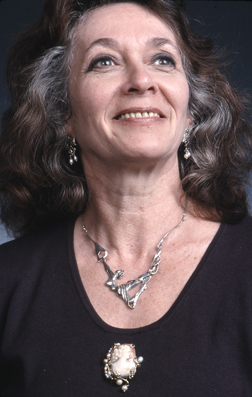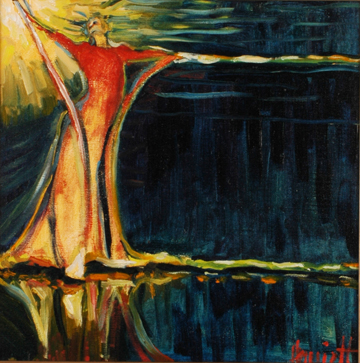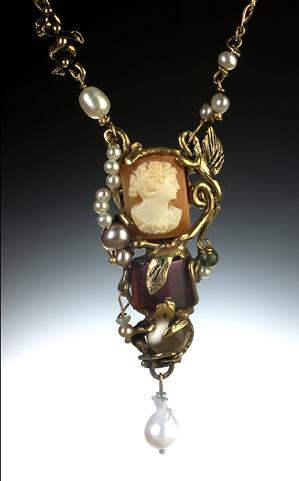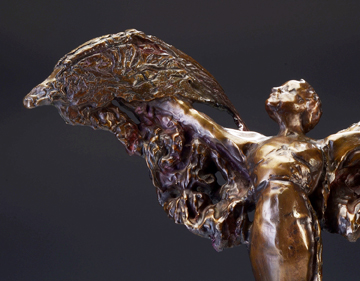 Harriet Forman Barrett Harriet Forman Barrett |
Profile: Harriet Forman Barrett
(all photos by Bob Barrett)By Raymond J. Steiner
ART TIMES July/ August 2012
JOIE dE VIVRE…I could stop here and you might have as complete a picture of Harriet Forman Barrett as you could ever have, for the “joy of living” not only permeates her entire body of work — sculpture, paintings, jewelry, mixed media — but her very being itself. In fact, she uses the term in her artist’s statement, telling us that her “work is a reminder of the belief in the joy of living.” Yet, to simply say that she believes in — even exemplifies the term — it is still merely a phrase and, to tell the truth, even a hackneyed one — and one must go far deeper than a cliché to capture in words a Harriet Forman Barrett.
I had the pleasant task of interviewing Harriet — and, from this point on, I shall continue to refer to her as “Harriet” since that is the signature she uses (almost always in red) to identify each work as coming from her own hand — one sunny afternoon in June which served as the perfect time for our meeting. The early warmth of Spring and the bright sunshine allowed Harriett to first take me on a stroll through her gardens. Artfully arranged, landscaped — we might as well say “sculpted” — the garden serves as a foil for her gem; specifically, her home — a study, atelier, gallery, art library, and sanctuary all beautifully melded into an intricate design that, almost immediately enveloped me in its charmed space. Sitting across from her and listening to her describe her work, her life, I quickly saw that I was sharing time with the kind of serious creator we all seek — or, at least, that I’ve been seeking throughout my years of writing about art and artists. I was slowly beginning to learn that the garden which enclosed the gem of her home ultimately pointed to the real gem within the gem — again, specifically, the creator of this inner sanctorum, Harriet herself.
 Tuning In-oil on canvas, framed |
The old Renaissance conception of “divine inspiration” has been largely lost to our modern world — to claim that one has been “breathed into by the Divinity” (the literal translation of the term) by an artist of today — even if fervently believed — might well bring a sneer of derision from the technologically savvy, “cutting-edge” connoisseur of today’s ultra-chic artworld. Nevertheless, that mysterious creative urge — whatever its ultimate source — yet exists and, if not bruited about by the “sophisticated” (if this means you, you might look up its meaning before you leap to claiming “sophistication” too quickly) — is fine and well, still opening up paths to inspiration to those who find nurturance in its presence.
 Timeless Totem-14k gold, antique cameo, tourmaline, moonstone, baroque pearl drop with pearls woven thru Timeless Totem-14k gold, antique cameo, tourmaline, moonstone, baroque pearl drop with pearls woven thru |
For Harriet, the urge came early in life — and as we find in the biographies of so many artists who awakened to it in unpropitious surroundings had that incipient craving to create either ignored or squelched — most often by parents who “wanted better” for their offspring; in Harriet’s case, her father, who wanted her to pursue a more conventional — i.e. lucrative — career. Neither parent reckoned on Harriet’s resolve. Neither parent was prepared for the explosion of creativity that was released when she finally got her way to avoid public school and attend the High School of Music and Art in New York City. Music, dance, painting, sculpture — the entire New York art scene — both flowed into and from their daughter in astonishing profusion. Awards, grants, and further outlets for Harriet’s unstoppable creative urge quickly followed her progress through Music and Art, on into her time at Pratt Institute — and beyond into a world of exhibitions, commissions, galleries and collections across the country, much of which Harriet attributes to the help and encouragement of her then Department Head, Henry P. Raleigh (later to be Head of the Art Department at SUNY, New Paltz and a writer, incidentally, for Art times almost since its inception in 1984). Little wonder, then, that she has created her garden within a garden, within a home, within her breast — still exploring, still delving, still hearkening to her inner Muses — her “divine inspiration” — and protecting it from a world rife with ignorance and sterility.
 Portrait of a Person (POPS),bronze with a marble base (detail) Portrait of a Person (POPS),bronze with a marble base (detail) |
Harriet’s work — her paintings, her sculpture, her jewelry — all bespeak her adherence to the “message” she receives from her creative center: Life is One. Although her primary focus is on the human form, for Harriet, no living thing falls outside the sacred chain of being. Human limbs entwine with tree limbs and both of them in a swirling matrix of energy that appears to sweep us all up together and upward, upward toward an ending that never seems to come, an ending that will forever be a becoming. The human figure appears early in Harriet’s work — and if her attention strays into still life or pure abstraction from time to time, her focus always comes back to the human. Often, her figures are granted wings, an adornment that allows the human form to soar ever higher, into the realm of Pure Being that, whether we will or not, informs us all.
 Stretch, bronze Stretch, bronze |
Harriet brought to my attention one of her sculptures, “Portrait of a Person” (bronze) that she allowed me to touch — an action that not many onlookers of sculpture are privileged to do. I was moved by both her gesture and, unexpectedly, by the tactile connection. I ran my fingers along the arch of the wing and felt a frisson from which I almost recoiled. It was strangely thrilling, as if the figure were transferring energy from itself to my fingertips. Art — good art — can always move me, but this was something special and I shall not easily forget the experience. Is it possible to “feel” another’s creative urge? I cannot answer this, but Harriet’s figures — in paintings, jewelry or sculpture — carry a potent impact. Although her twirling forms are almost uniformly lissome, elegant, graceful, they never lapse into the simply sexual, but rather evoke the female melding into male, ultimately morphing into an androgynous being that embodies both sexes striving for the Ultimate Union — for again, the message is: Life is One. These sculptural figures are echoed in her jewelry and, if not all possess wings, all defy the downward pull of gravity and reach for the heavens.
 The Reach- sterling silver, chrysacolla pendant |
To possess a work of her art — an original “Harriet” — to adorn either yourself or your home is to share in the artist’s spiritual journey. For Harriet, seeing her work of art in the hands of another who senses its divine origins is not simply a “sale” — it is a profound sharing of self with other self, of sharing in the oneness that connects us all. There remains a bond that transcends all others, whether familial, social, political or cultural. To those who believe, the creation of art is a spiritual journey with other seekers on the same path that one is not free to stray from or abandon to crass commerce without consequence.
 Life connections-oil on canvas, framed Life connections-oil on canvas, framed |
If her work is powerfully seductive, drawing the viewer into a blissful state of “One-ness”, one can clearly see that her vision of a spiritual interconnection does not end in her fingertips, those manipulators of ideas into tangible form. Harriet within herself exudes a confidence — a kind of surety that her message is not only clear but that it is right. Rather than her self-assuredness being a characteristic that might put some off, it is rather one that invites, promises — even ensures — a safe entry into her charmed circle of inner secrets. Once invited into her presence, one feels part of the mystery within which she has surrounded herself — a part of the garden, a part of the home with its walls and shelves full of her iconic sculptures, a part of her inner vision — a part, indeed, of Harriet Forman Barrett.
(For more information about Harriet Forman Barrett and images of her work, visit www.hformanbarrett.com).
